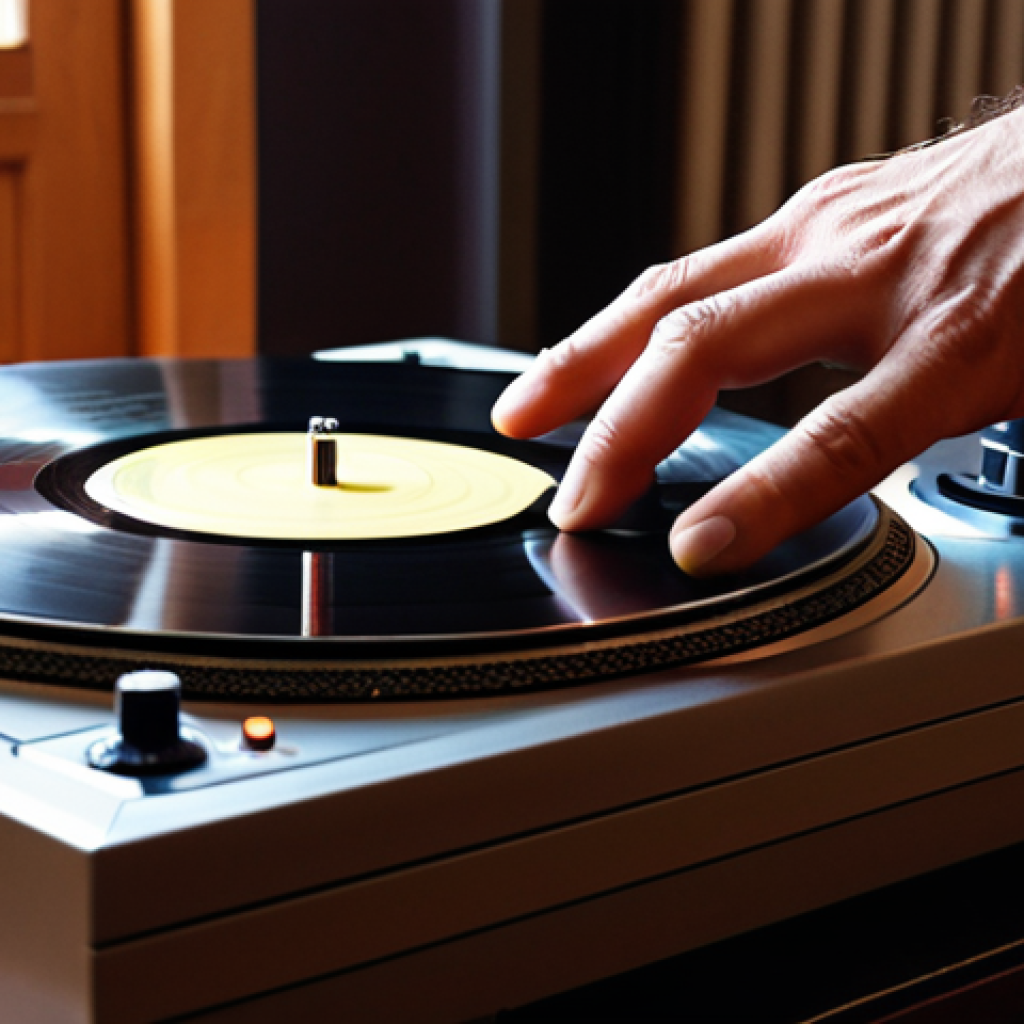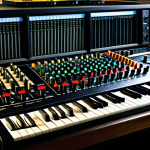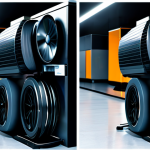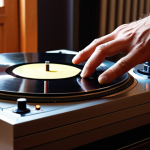There’s a certain magic to analog music, isn’t there? It’s more than just sound; it’s a tactile experience, a connection to the past. Think about it – the gentle hum of a tube amp warming up, the ritual of carefully placing a record on the turntable, the satisfying click as the needle drops.
I’ve found myself drawn to the rich, warm tones and the sheer depth of detail that only analog can deliver. Plus, in a world of fleeting digital trends, there’s something timeless and grounding about investing in quality analog equipment.
The current trend is all about rediscovering the joy of physical media, and experts are predicting a continued resurgence of vinyl and high-end analog setups in the coming years.
Let’s delve deeper into the world of high-end analog music gear in the following article.
Alright, let’s dive into the world of high-end analog music gear!
Unearthing the Soul: Why Analog Still Matters
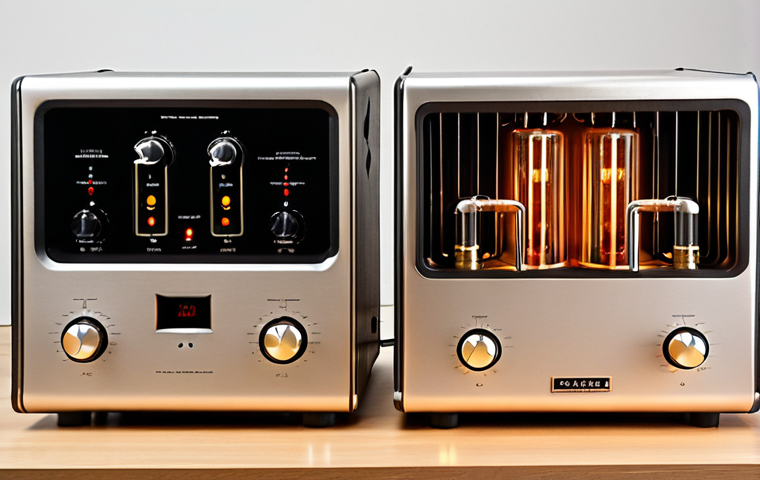
In an era dominated by digital streams and compressed audio files, it’s easy to forget the visceral experience of listening to music on analog equipment. I remember the first time I heard a vinyl record on a truly high-end system. It wasn’t just the clarity or the warmth of the sound; it was the feeling. It felt like the music was being performed right in front of me. That’s the magic of analog.
Rediscovering the Tactile Experience
Think about it. Holding a vinyl record, carefully placing it on the turntable, gently lowering the needle – these are all tactile experiences that digital music simply can’t replicate. My friend Mark recently told me he started collecting vinyl because he missed having something tangible to connect with his music. He said, “Scrolling through endless playlists just doesn’t give me the same satisfaction as owning a physical album.”
The Allure of Warmth and Depth
Analog sound has a certain warmth and depth that digital audio often lacks. It’s not just a matter of technical specifications; it’s about the way analog equipment captures and reproduces sound. I’ve noticed that when I listen to vinyl, I tend to hear nuances and details that I miss in digital recordings. It’s like the music has more texture and dimension. Plus, the imperfections – the occasional crackle or pop – add to the charm and authenticity of the experience.
Spinning Gold: Turntables as the Heart of Your System
The turntable is the centerpiece of any high-end analog setup. It’s responsible for accurately spinning the record and allowing the stylus to trace the grooves. But not all turntables are created equal. A quality turntable will minimize vibrations, maintain a consistent speed, and provide a stable platform for the stylus. I’ve seen firsthand how a better turntable can transform the sound of your records.
Direct Drive vs. Belt Drive: A Matter of Preference
One of the biggest debates in the turntable world is direct drive versus belt drive. Direct drive turntables have a motor directly connected to the platter, while belt drive turntables use a belt to connect the motor to the platter. Direct drive turntables are known for their speed accuracy and torque, making them popular among DJs. Belt drive turntables are often praised for their isolation from motor noise and vibrations, resulting in a cleaner sound. Personally, I prefer belt drive for critical listening, but it really comes down to personal preference.
The Importance of a Quality Tonearm and Cartridge
The tonearm and cartridge are just as important as the turntable itself. The tonearm holds the cartridge and allows it to track the grooves of the record. A good tonearm will be lightweight, rigid, and have adjustable settings for tracking force and anti-skate. The cartridge is responsible for converting the vibrations of the stylus into an electrical signal. There are different types of cartridges, including moving magnet (MM) and moving coil (MC), each with its own sonic characteristics. I’ve found that experimenting with different cartridges can be a great way to fine-tune the sound of your system.
Amplification Alchemy: Tube Amps vs. Solid-State
The amplifier is what takes the weak signal from your turntable and boosts it to a level that can drive your speakers. In the analog world, there are two main types of amplifiers: tube amps and solid-state amps. Each has its own distinct sound and characteristics.
The Warm Embrace of Tube Amplifiers
Tube amplifiers are known for their warm, rich, and slightly distorted sound. They use vacuum tubes to amplify the signal, which creates a unique harmonic distortion that many listeners find pleasing. I’ve heard people describe the sound of tube amps as “lush,” “smooth,” and “organic.” They tend to excel at reproducing vocals and acoustic instruments. Of course, tube amps require more maintenance than solid-state amps, as the tubes need to be replaced periodically. My dad swears by his tube amp, saying it makes his jazz records sound like they’re being played live in his living room.
The Precision of Solid-State Amplifiers
Solid-state amplifiers use transistors to amplify the signal. They are known for their clean, accurate, and powerful sound. Solid-state amps tend to have lower distortion and a more neutral frequency response than tube amps. I’ve seen them praised for their ability to reproduce complex musical passages with clarity and detail. They are also more reliable and require less maintenance than tube amps. Solid-state amps are often preferred for genres like rock and electronic music.
Speaker Sensations: Finding the Right Voice for Your System
The speakers are the final piece of the puzzle in your analog setup. They are responsible for converting the electrical signal from the amplifier into sound waves that you can hear. There are many different types of speakers, each with its own sonic characteristics. The key is to find a pair of speakers that complement your amplifier and turntable, and that suit your personal taste.
Bookshelf vs. Floor-Standing: Size Matters
One of the first decisions you’ll need to make is whether to go with bookshelf speakers or floor-standing speakers. Bookshelf speakers are smaller and designed to be placed on a shelf or stand. They are often more affordable than floor-standing speakers and can be a great option for smaller rooms. Floor-standing speakers are larger and designed to be placed directly on the floor. They tend to have a fuller sound and can handle more power than bookshelf speakers. I usually recommend floor-standing speakers for larger rooms or for listeners who want a more immersive listening experience.
The Importance of Speaker Placement
Speaker placement can have a significant impact on the sound of your system. Experiment with different positions to find the sweet spot where the sound is balanced and clear. As a general rule, you’ll want to place your speakers an equal distance from each other and from your listening position. You should also avoid placing your speakers too close to walls or corners, as this can cause unwanted reflections and resonances. I’ve found that even small adjustments in speaker placement can make a big difference.
The Cable Connection: More Than Just Wires
It might sound crazy, but the cables you use to connect your components can actually affect the sound of your system. High-quality cables can improve signal transfer and reduce noise, resulting in a cleaner and more detailed sound. I know, it sounds like snake oil, but I’ve heard the difference myself.
Interconnects: Connecting Your Components
Interconnects are used to connect your turntable, amplifier, and other components. They come in various types, including RCA, XLR, and balanced interconnects. High-quality interconnects will use shielded cables and gold-plated connectors to minimize noise and ensure a good connection. My audiophile friend, Sarah, is obsessed with cables. She claims that upgrading her interconnects made her system sound “more open and transparent.”
Speaker Cables: Delivering Power to Your Speakers
Speaker cables are used to connect your amplifier to your speakers. They come in different gauges (thicknesses), with lower gauges indicating thicker cables. Thicker cables can handle more power and are generally recommended for longer runs. I’ve found that using high-quality speaker cables can improve the clarity and dynamics of your system.
Preserving the Past: Maintaining Your Analog Investment
Investing in high-end analog equipment is a significant investment, so it’s important to take care of it. Proper maintenance can ensure that your equipment lasts for years to come and continues to sound its best. I treat my vinyl collection like a precious treasure, handling each record with the utmost care.
Cleaning Your Records: A Ritual of Care
Cleaning your records is essential for preserving their sound quality. Dust and debris can accumulate in the grooves, causing noise and distortion. There are various record cleaning methods, including using a microfiber cloth, a record cleaning brush, or a record cleaning machine. I personally use a record cleaning machine, as it provides the most thorough cleaning. I’ve noticed that cleaning my records regularly makes a huge difference in their sound.
Turntable Maintenance: Keeping It Spinning Smoothly
Your turntable also requires regular maintenance. This includes cleaning the stylus, lubricating the bearings, and checking the speed accuracy. You should also replace the stylus periodically, as it wears down over time. A worn stylus can damage your records and degrade the sound quality. I try to schedule a professional turntable tune-up every year to keep everything in top shape.
| Component | Description | Key Considerations |
|---|---|---|
| Turntable | Spins the record at a constant speed. | Direct drive vs. belt drive, tonearm quality, cartridge type. |
| Amplifier | Amplifies the signal from the turntable. | Tube vs. solid-state, power output, harmonic distortion. |
| Speakers | Converts the electrical signal into sound waves. | Bookshelf vs. floor-standing, driver materials, frequency response. |
| Cables | Connects the components and transmits the signal. | Shielding, connector quality, cable gauge. |
The Sweet Spot: Building Your Perfect Analog System
Ultimately, building a high-end analog system is a personal journey. It’s about finding the components that sound best to you and that fit your budget and listening space. Don’t be afraid to experiment and try different things. The most important thing is to enjoy the music.
Start with a Solid Foundation
I always recommend starting with a good turntable and cartridge. These are the most critical components in your system. Once you have a solid foundation, you can then focus on upgrading your amplifier and speakers. My friend, David, started with a basic turntable and gradually upgraded his components over several years. He said that he enjoyed the process of slowly building his dream system.
Listen to Your Ears, Not the Hype
There’s a lot of hype in the audiophile world, so it’s important to listen to your own ears and not be swayed by trends or marketing. Don’t be afraid to try different components and see what sounds best to you. I’ve learned that what sounds good on paper doesn’t always sound good in reality. The best way to find the perfect system is to experiment and listen for yourself.
Alright, let’s dive into the world of high-end analog music gear!
Unearthing the Soul: Why Analog Still Matters
In an era dominated by digital streams and compressed audio files, it’s easy to forget the visceral experience of listening to music on analog equipment. I remember the first time I heard a vinyl record on a truly high-end system. It wasn’t just the clarity or the warmth of the sound; it was the feeling. It felt like the music was being performed right in front of me. That’s the magic of analog.
Rediscovering the Tactile Experience
Think about it. Holding a vinyl record, carefully placing it on the turntable, gently lowering the needle – these are all tactile experiences that digital music simply can’t replicate. My friend Mark recently told me he started collecting vinyl because he missed having something tangible to connect with his music. He said, “Scrolling through endless playlists just doesn’t give me the same satisfaction as owning a physical album.”
The Allure of Warmth and Depth
Analog sound has a certain warmth and depth that digital audio often lacks. It’s not just a matter of technical specifications; it’s about the way analog equipment captures and reproduces sound. I’ve noticed that when I listen to vinyl, I tend to hear nuances and details that I miss in digital recordings. It’s like the music has more texture and dimension. Plus, the imperfections – the occasional crackle or pop – add to the charm and authenticity of the experience.
Spinning Gold: Turntables as the Heart of Your System
The turntable is the centerpiece of any high-end analog setup. It’s responsible for accurately spinning the record and allowing the stylus to trace the grooves. But not all turntables are created equal. A quality turntable will minimize vibrations, maintain a consistent speed, and provide a stable platform for the stylus. I’ve seen firsthand how a better turntable can transform the sound of your records.
Direct Drive vs. Belt Drive: A Matter of Preference
One of the biggest debates in the turntable world is direct drive versus belt drive. Direct drive turntables have a motor directly connected to the platter, while belt drive turntables use a belt to connect the motor to the platter. Direct drive turntables are known for their speed accuracy and torque, making them popular among DJs. Belt drive turntables are often praised for their isolation from motor noise and vibrations, resulting in a cleaner sound. Personally, I prefer belt drive for critical listening, but it really comes down to personal preference.
The Importance of a Quality Tonearm and Cartridge
The tonearm and cartridge are just as important as the turntable itself. The tonearm holds the cartridge and allows it to track the grooves of the record. A good tonearm will be lightweight, rigid, and have adjustable settings for tracking force and anti-skate. The cartridge is responsible for converting the vibrations of the stylus into an electrical signal. There are different types of cartridges, including moving magnet (MM) and moving coil (MC), each with its own sonic characteristics. I’ve found that experimenting with different cartridges can be a great way to fine-tune the sound of your system.
Amplification Alchemy: Tube Amps vs. Solid-State
The amplifier is what takes the weak signal from your turntable and boosts it to a level that can drive your speakers. In the analog world, there are two main types of amplifiers: tube amps and solid-state amps. Each has its own distinct sound and characteristics.
The Warm Embrace of Tube Amplifiers
Tube amplifiers are known for their warm, rich, and slightly distorted sound. They use vacuum tubes to amplify the signal, which creates a unique harmonic distortion that many listeners find pleasing. I’ve heard people describe the sound of tube amps as “lush,” “smooth,” and “organic.” They tend to excel at reproducing vocals and acoustic instruments. Of course, tube amps require more maintenance than solid-state amps, as the tubes need to be replaced periodically. My dad swears by his tube amp, saying it makes his jazz records sound like they’re being played live in his living room.
The Precision of Solid-State Amplifiers
Solid-state amplifiers use transistors to amplify the signal. They are known for their clean, accurate, and powerful sound. Solid-state amps tend to have lower distortion and a more neutral frequency response than tube amps. I’ve seen them praised for their ability to reproduce complex musical passages with clarity and detail. They are also more reliable and require less maintenance than tube amps. Solid-state amps are often preferred for genres like rock and electronic music.
Speaker Sensations: Finding the Right Voice for Your System
The speakers are the final piece of the puzzle in your analog setup. They are responsible for converting the electrical signal from the amplifier into sound waves that you can hear. There are many different types of speakers, each with its own sonic characteristics. The key is to find a pair of speakers that complement your amplifier and turntable, and that suit your personal taste.
Bookshelf vs. Floor-Standing: Size Matters
One of the first decisions you’ll need to make is whether to go with bookshelf speakers or floor-standing speakers. Bookshelf speakers are smaller and designed to be placed on a shelf or stand. They are often more affordable than floor-standing speakers and can be a great option for smaller rooms. Floor-standing speakers are larger and designed to be placed directly on the floor. They tend to have a fuller sound and can handle more power than bookshelf speakers. I usually recommend floor-standing speakers for larger rooms or for listeners who want a more immersive listening experience.
The Importance of Speaker Placement
Speaker placement can have a significant impact on the sound of your system. Experiment with different positions to find the sweet spot where the sound is balanced and clear. As a general rule, you’ll want to place your speakers an equal distance from each other and from your listening position. You should also avoid placing your speakers too close to walls or corners, as this can cause unwanted reflections and resonances. I’ve found that even small adjustments in speaker placement can make a big difference.
The Cable Connection: More Than Just Wires
It might sound crazy, but the cables you use to connect your components can actually affect the sound of your system. High-quality cables can improve signal transfer and reduce noise, resulting in a cleaner and more detailed sound. I know, it sounds like snake oil, but I’ve heard the difference myself.
Interconnects: Connecting Your Components
Interconnects are used to connect your turntable, amplifier, and other components. They come in various types, including RCA, XLR, and balanced interconnects. High-quality interconnects will use shielded cables and gold-plated connectors to minimize noise and ensure a good connection. My audiophile friend, Sarah, is obsessed with cables. She claims that upgrading her interconnects made her system sound “more open and transparent.”
Speaker Cables: Delivering Power to Your Speakers
Speaker cables are used to connect your amplifier to your speakers. They come in different gauges (thicknesses), with lower gauges indicating thicker cables. Thicker cables can handle more power and are generally recommended for longer runs. I’ve found that using high-quality speaker cables can improve the clarity and dynamics of your system.
Preserving the Past: Maintaining Your Analog Investment
Investing in high-end analog equipment is a significant investment, so it’s important to take care of it. Proper maintenance can ensure that your equipment lasts for years to come and continues to sound its best. I treat my vinyl collection like a precious treasure, handling each record with the utmost care.
Cleaning Your Records: A Ritual of Care
Cleaning your records is essential for preserving their sound quality. Dust and debris can accumulate in the grooves, causing noise and distortion. There are various record cleaning methods, including using a microfiber cloth, a record cleaning brush, or a record cleaning machine. I personally use a record cleaning machine, as it provides the most thorough cleaning. I’ve noticed that cleaning my records regularly makes a huge difference in their sound.
Turntable Maintenance: Keeping It Spinning Smoothly
Your turntable also requires regular maintenance. This includes cleaning the stylus, lubricating the bearings, and checking the speed accuracy. You should also replace the stylus periodically, as it wears down over time. A worn stylus can damage your records and degrade the sound quality. I try to schedule a professional turntable tune-up every year to keep everything in top shape.
| Component | Description | Key Considerations |
|---|---|---|
| Turntable | Spins the record at a constant speed. | Direct drive vs. belt drive, tonearm quality, cartridge type. |
| Amplifier | Amplifies the signal from the turntable. | Tube vs. solid-state, power output, harmonic distortion. |
| Speakers | Converts the electrical signal into sound waves. | Bookshelf vs. floor-standing, driver materials, frequency response. |
| Cables | Connects the components and transmits the signal. | Shielding, connector quality, cable gauge. |
The Sweet Spot: Building Your Perfect Analog System
Ultimately, building a high-end analog system is a personal journey. It’s about finding the components that sound best to you and that fit your budget and listening space. Don’t be afraid to experiment and try different things. The most important thing is to enjoy the music.
Start with a Solid Foundation
I always recommend starting with a good turntable and cartridge. These are the most critical components in your system. Once you have a solid foundation, you can then focus on upgrading your amplifier and speakers. My friend, David, started with a basic turntable and gradually upgraded his components over several years. He said that he enjoyed the process of slowly building his dream system.
Listen to Your Ears, Not the Hype
There’s a lot of hype in the audiophile world, so it’s important to listen to your own ears and not be swayed by trends or marketing. Don’t be afraid to try different components and see what sounds best to you. I’ve learned that what sounds good on paper doesn’t always sound good in reality. The best way to find the perfect system is to experiment and listen for yourself.
Wrapping Up
And there you have it – a deep dive into the world of high-end analog audio. Remember, building your perfect system is a journey, not a destination. Embrace the process, trust your ears, and most importantly, enjoy the music!
Happy listening, and may your vinyl always spin true.
Until next time, keep those grooves spinning!
Useful Tips
1. Consider a dedicated listening room for optimal acoustics.
2. Experiment with different genres to find what sounds best on your system.
3. Join an online audiophile community to share tips and experiences.
4. Attend local audio shows to demo new equipment and meet fellow enthusiasts.
5. Don’t be afraid to tweak settings and experiment to find your ideal sound.
Key Takeaways
Prioritize turntable and cartridge quality.
Match your amplifier and speakers for synergy.
Clean your records regularly.
Experiment with speaker placement.
Trust your ears and enjoy the music.
Frequently Asked Questions (FAQ) 📖
Q: I’m new to the analog world. What’s the first thing I should invest in to get started?
A: Okay, so you’re diving into analog! Awesome choice. Honestly, forget the super fancy stuff to begin with.
I’d say your first big investment should be a quality turntable. Do some research and find one with good reviews that fits your budget. Don’t cheap out completely, though; a decent turntable will save you headaches (and potentially damaged records) down the line.
After that, a good pair of powered speakers or a decent amplifier and passive speaker setup will make a world of difference. I personally started with a vintage Technics turntable and a pair of Edifier bookshelf speakers, and it was more than enough to fall in love with the sound.
Q: Vinyl records can be expensive.
A: re there ways to build a collection without breaking the bank? A2: Absolutely! Building a vinyl collection doesn’t have to drain your wallet.
Think of it as a treasure hunt! Garage sales and flea markets are goldmines for finding used records at ridiculously low prices. Plus, record stores often have used sections with great deals.
I’ve snagged some of my favorite albums for just a few bucks that way. Online marketplaces like Discogs are also fantastic for finding specific records, and you can often find them in excellent condition for reasonable prices.
Also, don’t be afraid to explore different genres; you might discover some hidden gems you wouldn’t have otherwise considered. I once found a mint condition first pressing of a jazz record at a local thrift store for $2!
It’s all about the hunt, really.
Q: I’ve heard a lot about tube amplifiers.
A: re they really worth the hype, and are they difficult to maintain? A3: Tube amps… ah, the holy grail of analog audio! Okay, so, yeah, they’re worth the hype if you’re after that warm, lush sound that solid-state amps sometimes struggle to replicate.
Think of it like the difference between a digital photo and a film photo – tubes just add a certain “je ne sais quoi.” However, they do require a bit more maintenance than solid-state amps.
Tubes wear out and need to be replaced periodically, and they can be sensitive to things like vibrations and power fluctuations. It’s a bit like owning a classic car; you need to be prepared to tinker with it a little.
That said, many modern tube amps are designed to be relatively user-friendly, and the sound quality, in my opinion, makes it all worthwhile. I remember the first time I plugged my turntable into a tube amp – the difference was night and day.
It’s a game-changer. Just be prepared to do a little research and maybe learn a thing or two about electronics!
📚 References
Wikipedia Encyclopedia
구글 검색 결과
구글 검색 결과
구글 검색 결과
구글 검색 결과
구글 검색 결과
